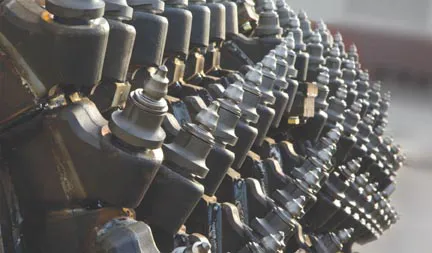Element 6 is now looking to push into North America with its innovative milling cutter products. Part of the De Beers Group, Element 6 has benefited from its parent’s expertise with diamond technology and is offering milling cutters featuring diamond chips.
March 8, 2014
Read time: 3 mins
Element 6 is now looking to push into North America with its innovative milling cutter products. Part of the De Beers Group, Element 6 has benefited from its parent’s expertise with diamond technology and is offering milling cutters featuring diamond chips.
Simon Hardy, business manager for the road sector for Element 6, said that the firm’s use of industrial diamond technologies has been well accepted in a variety of industries. “We’ve a good reputation for high performance,” he said.
The milling cutters are already proving successful in some segments and, according to Hardy, “the high growth areas for us are road building and extraction. In Europe we’re going direct to end users and we are taking this approach in the US too, but in other markets we go through OEMs.”
Because the D Power cutters from Element 6 feature industrial diamonds, they are not cheap. Hardy admitted the products can cost 30-40 times as much as conventional tungsten carbide cutters, a fact that can be off-putting to contractors on first sight.
However, he explained that the wear life of the firm’s D Power cutters is typically 40 times as long as that of a conventional tungsten carbide cutter. This long working life is a key issue, as it vastly extends the time between tool changes and cuts a significant sum from maintenance costs and machine downtime. Hardy said, “Any time the machine is not working, it’s a cost.”
There are other notable benefits too as he explained, “You get around 7% fuel saving and in some cases we’ve seen 10-15% fuel saving. You get less vibration on the machine, so there’s less wear and tear and that machine will last longer.”
Also, Hardy added, because the cutters remain Sharp, they cut more efficiently and reduce the effect seen with tungsten carbide cutters of progressively less efficient operation as they wear. In some instances milling contractors may remove tungsten carbide cutters from the machine before the wear life is complete, because the cutting performance and efficiency has reduced, while machine vibration and fuel consumption has increased.
“You get a really good surface finish,” he added, saying that for clients that make this a requirement, it can offer added benefits for a performance contract. These performance advantages are becoming well understood by milling contractors in markets where the products have been available for some time. “In Sweden now we’re seeing over 50% of milling is with diamond cutters,” he said, adding that a contractor in Germany has run the cutters 24 hours/day over the course of a few days, with no lessening of cutting performance. “We’ve had a lot of interest from contractors in the US.”
The products available at present are suited to the well accepted2395 Wirtgen tool holder type. But the firm is also able to make tool holders for other leading milling equipment specialists. Hardy said, “We’re not just putting the diamond on any old carbide.” The design of the body ensures good material flow and also copes with the extended use.
The milling cutter technology is also suited to surface mining applications and the company is researching this market segment at present. For the extraction of limestone from a quarry, a surface miner can be a useful machine and the prospect of extended times between service intervals for toll maintenance would arguably be of even more economic benefit to that market segment.
The company has a new research facility in the UK for its industrial diamonds and Hardy said that there is a Cross-fertilisation of technologies from other markets that will offer further performance gains for road milling as well as surface mining in the future.
%$Linker:2 Asset <?xml version="1.0" encoding="utf-16"?><dictionary /> 2 42623 0 oLinkExternal www.e6.com Visit Element Six Website false /EasySiteWeb/GatewayLink.aspx?alId=42623 false false %>
Simon Hardy, business manager for the road sector for Element 6, said that the firm’s use of industrial diamond technologies has been well accepted in a variety of industries. “We’ve a good reputation for high performance,” he said.
The milling cutters are already proving successful in some segments and, according to Hardy, “the high growth areas for us are road building and extraction. In Europe we’re going direct to end users and we are taking this approach in the US too, but in other markets we go through OEMs.”
Because the D Power cutters from Element 6 feature industrial diamonds, they are not cheap. Hardy admitted the products can cost 30-40 times as much as conventional tungsten carbide cutters, a fact that can be off-putting to contractors on first sight.
However, he explained that the wear life of the firm’s D Power cutters is typically 40 times as long as that of a conventional tungsten carbide cutter. This long working life is a key issue, as it vastly extends the time between tool changes and cuts a significant sum from maintenance costs and machine downtime. Hardy said, “Any time the machine is not working, it’s a cost.”
There are other notable benefits too as he explained, “You get around 7% fuel saving and in some cases we’ve seen 10-15% fuel saving. You get less vibration on the machine, so there’s less wear and tear and that machine will last longer.”
Also, Hardy added, because the cutters remain Sharp, they cut more efficiently and reduce the effect seen with tungsten carbide cutters of progressively less efficient operation as they wear. In some instances milling contractors may remove tungsten carbide cutters from the machine before the wear life is complete, because the cutting performance and efficiency has reduced, while machine vibration and fuel consumption has increased.
“You get a really good surface finish,” he added, saying that for clients that make this a requirement, it can offer added benefits for a performance contract. These performance advantages are becoming well understood by milling contractors in markets where the products have been available for some time. “In Sweden now we’re seeing over 50% of milling is with diamond cutters,” he said, adding that a contractor in Germany has run the cutters 24 hours/day over the course of a few days, with no lessening of cutting performance. “We’ve had a lot of interest from contractors in the US.”
The products available at present are suited to the well accepted
The milling cutter technology is also suited to surface mining applications and the company is researching this market segment at present. For the extraction of limestone from a quarry, a surface miner can be a useful machine and the prospect of extended times between service intervals for toll maintenance would arguably be of even more economic benefit to that market segment.
The company has a new research facility in the UK for its industrial diamonds and Hardy said that there is a Cross-fertilisation of technologies from other markets that will offer further performance gains for road milling as well as surface mining in the future.
%$Linker:









